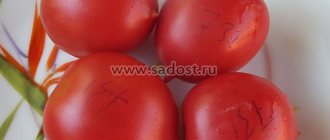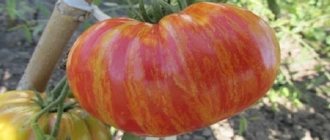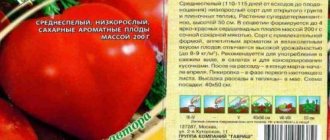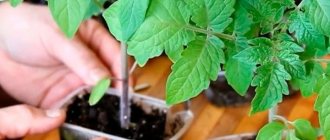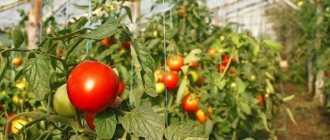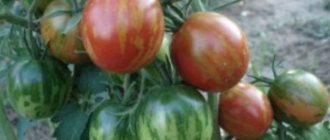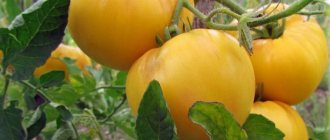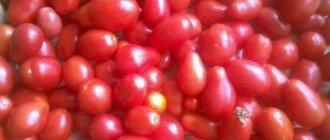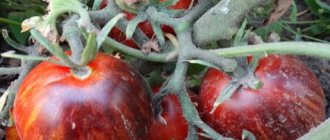All gardeners love productive, easy-to-use tomato varieties. These include the Crimean rose - a beautiful and tasty tomato with an unusual shape, similar to a pear.
| Height | Landing location | Ripening time | Fruit color | Fruit size | Origin | Fruit shape |
| Medium height | Greenhouse, Open ground | Mid-early | Pink | Average | Variety | Pear-shaped |
Boarding order
Tomato Black Crimea can be obtained by seedlings.
To do this, at home, seeds are planted in small boxes. When the plants reach one and a half to two months, they are transferred to a greenhouse or an open area. It is allowed to plant seeds directly in open ground under favorable climatic conditions in the region.
Preparing seedlings
To obtain tomato seedlings, prepare soil consisting of equal proportions of humus and turf soil. It is recommended to pre-treat the soil by heating it in the oven or placing it in the freezer. After 2 weeks, you can begin planting work.
Seed material is also processed. It is soaked for a day in warm water to stimulate the appearance of sprouts. Purchased tomato seeds have already undergone similar processing, so you can start planting them immediately.
Advice! Prepare boxes or cups 10 cm deep for seedlings.
Furrows are made on the surface of the soil to a depth of 1 cm. Seeds are placed every 2 cm. After planting, the containers are covered with glass or film, after which they are left in a dark and warm place.
According to reviews of the Black Crimean tomato, at a temperature of 25-30 degrees, seedlings appear in 3 days. If the ambient temperature is lower, growth will take longer.
The seedlings are moved to the windowsill, and constant lighting is provided for 12 hours. Water the tomatoes periodically to prevent the soil from drying out.
Planting in a greenhouse
Tomato seedlings that have reached 20 cm in height are transferred to the greenhouse. Such plants have 3-4 leaves and a developed root system.
The soil for tomatoes is dug up in the fall. The top layer of soil is removed to avoid the spread of diseases and pests in the future. Tomatoes are not grown in one place for two years in a row.
Advice! In autumn, humus or compost is added to the soil.
The Black Crimean variety is planted in rows or in a checkerboard pattern. Leave 60 cm between plants and 70 cm between rows.
To plant tomatoes, make a hole into which the root system is placed. Then the roots of the plant are covered and the soil is slightly compacted. The final stage is watering the plants.
Planting in open ground
In regions with a warm climate, seedlings of the Black Crimea variety are transferred to open ground. Reviews of the Black Crimean tomato show that these tomatoes grow well in the open air.
The planting scheme is as follows: an interval of 60 cm is maintained between plants. Tomatoes can be planted in several rows.
Advice! For tomatoes, choose beds where cucumbers, turnips, cabbage, melons and legumes previously grew.
If tomatoes or peppers were already growing in the beds, then replanting of the crop is not carried out. Compost or rotted manure is used as soil fertilizer.
In the fall, the beds need to be dug up. In the spring, deep loosening is carried out and holes are prepared for planting. Tomatoes should be transferred to open ground after warm weather sets in. The air and soil should warm up well. If the threat of cold weather remains, the tomatoes are covered with agrofibre.
You can plant seeds of the Black Crimea variety in open ground. However, it will take longer to harvest.
Tricks for abundant fruiting
Basically, caring for Crimean Rose tomatoes is simple. Seeds for seedlings are sown from late February to mid-March. Sowing is allowed until the first days of April. A soil mixture of compost, peat, sand, and garden turf is suitable for seedlings. You can plant in peat tablets, but then you need to sort the planting material and pre-treat it with Kornevin or Zircon. This will give the seeds a reserve of strength for faster germination and before the formation of the first real leaf. The second feeding is carried out during picking.
They take root equally well in greenhouses and open ground; the difference in planting dates depends on the climatic conditions of a particular region. For the garden bed, choose a well-lit place away from trees and shrubs. It is recommended to follow the principle of alternation, for example, tomatoes feel great in the place where beans, peas, carrots, and garlic previously grew.
Watering is carried out 2 - 3 times a week, at the root. Before watering, pinching is necessary.
It should be remembered: this variety requires fertilizing regularly, approximately once every 14 days. 2 - 3 weeks before planting in open ground, gradual hardening is carried out, the cassettes with seedlings are taken out into the sun in a place protected from the wind, gradually increasing the time.
The Crimean rose tomato is suitable for beginners in gardening, always delighting with a good harvest.
tomato Louis 17 - description and characteristics of the variety
TOMATOES IN POTS - VIDEO
Tomatoes in pots.
ORDER QUALITY AND CHEAP SEEDS AND OTHER GOODS FOR YOUR HOME AND GARDEN. PRICES ARE PRICEY. CHECKED! JUST LOOK FOR YOURSELF AND BE SURPRISED. THERE ARE REVIEWS. GO>>>
- Dwarf tomatoes - growing, planting and care: WHAT ARE GOOD DAMN VARIETIES OF THE FAMOUS...
- Blue tomato varieties (photo): Varieties of blue tomatoes Back at the beginning...
- Yellow tomatoes - the most delicious varieties: name and description: The best varieties of yellow tomatoes MOST GARDENERS...
- Tomatoes with blue, purple, black and brown fruits: Tomatoes to which you are not allergic...
- The earliest varieties of tomatoes (Oregon, Labrador, etc.) reviews, planting and care: EARLY VARIETIES OF TOMATOES FOR THE MIDDLE…
- Green varieties of tomatoes - photo, name and description: GROWING GREEN TOMATOES - VARIETIES...
- A seedless method of growing tomatoes and varieties of tomatoes for it: Seedlings for tomatoes are optional Here's about...
Characteristics of the variety
Tomato cultivation is provided in open ground, greenhouses and hotbeds. The plant tolerates drought and minor temperature changes well. This variety of tomatoes is popular in Crimea and is one of the best tomatoes in terms of its characteristics.
The Crimean Rose tomato variety is a semi-determinate species. The height of an adult plant reaches an average of 1.2-1.5 m. The bush has a strong and powerful root system. The trunk is massive, but still needs additional support. The branches are not spreading. The plant looks compact and neat, and the foliage fills the bush quite tightly.
Features of growing tomatoes
Sowing of Biyskaya Rosa tomato seedlings is carried out from March to mid-April or 60 days before the planned transplant date.
Growing seedlings
Seeds of a tomato variety must undergo preparation and preliminary processing. To combat diseases and pests, the seed undergoes a disinfection process.
The most popular remedy is potassium permanganate solution. Tomato seeds are placed in a weak pale pink solution for 15 minutes. After this, they must be washed in running water.
Tomato seedlings can be grown in any container. Containers and equipment must be disinfected before work. A layer of drainage 2-3 cm thick is poured onto the bottom. For this you can use small stones, pebbles, and expanded clay.
The soil mixture is poured over the drainage and compacted tightly. The seeds are deepened by 1-1.5 cm, they can be placed in already prepared grooves at intervals of 3 cm. The crops are covered with a thin layer of soil and watered.
Watering the variety is done with warm water from a spray bottle. For the emergence of friendly shoots, the crops are covered with plastic film or glass. It is advisable to withstand temperatures of + 24, +25 degrees.
Watering the seedlings is carried out as the top layer of soil dries. Twice during the period of growing seedlings, fertilizing with a mineral fertilizer complex is carried out. The first time - after a week in the diving field, the second time - a week before transplanting into the ground.
Diving tomatoes
When the first two true full-fledged leaves are formed, a dive is carried out. For Biyskaya Rose tomatoes, this procedure is necessary.
A couple of hours before the procedure, the seedlings need to be watered abundantly, so the soil will become much softer
Carefully dig under the root and transfer to prepared containers with drainage and soil. The bushes are deepened to the first cotyledon leaves, then watered well
Within a week, the seedlings will get used to the new place and begin the rooting process. Afterwards feeding is carried out.
Transplantation into the ground
To make tomatoes more easily tolerate transplantation and sudden changes in growth conditions, they are hardened a week before the planting date.
First, the seedlings are taken out onto the balcony or street for 15-30 minutes, and the stay time is increased every day. On the last day, if there is no frost, you can leave it for a day.
Replanting begins when the weather stabilizes, night frosts stop, and the soil warms up to +14 degrees.
Biyskaya Rosa tomatoes are very spreading, so the holes should be located at a considerable distance. Planting frequency is 2-3 bushes per 1 square meter. Humus or rotted leaves are placed in the holes. They are watered generously with warm water. The seedlings are deepened in the center and covered with earth. They do not require watering for a week.
Description of the Tea Rose tomato and characteristics of the variety
The “Tea Rose” tomato was bred by Russian breeders and has a number of advantages.
Characteristics of the variety: mid-early, indeterminate, large-fruited, resistant to many tomato diseases. Created specifically for greenhouse cultivation, but in regions with a stable warm climate it is also grown in open ground. Tomatoes of this variety can be grown all year round in heated greenhouses.
A bush of this variety grows up to 1.8-2 m high, so it definitely requires gartering to a vertical or horizontal support. The stem is liana-shaped and flexible. The formation of the stem of this tomato is carried out as the plant grows into 1-2 trunks. Since the fruits are quite large, it is necessary to tie the trunk to a support.
The leaves of the seedlings are light, and when the plant gains growth, they become dark green, slightly elongated. For 1 sq. m plant 4-5 plants. The plant is tall, so planting is done using the 50 x 50 cm technology. The period from seed germination to fruiting of the plant is 110-115 days.
Fruit characteristics
Description of the fruits of the “Tea Rose” variety of tomatoes: large, perfectly round, smooth, fleshy, sugary tomatoes at the break. The color of a ripe tomato is soft pink with a pearlescent sheen. The skin of these tomatoes is tender but dense. Tea Rose tomatoes do not crack.
It has a good delicate taste and pleasant aroma. They are consumed fresh and in salads. Small fruits can be preserved in their entirety, and large ones in slices or in the form of juice, puree, or sauce. Reviews of this variety are positive, noting the good presentation, as well as some decorativeness of the variety.
The size of the fruits on the bush is not the same and ranges from 120 to 300 grams (individual fruits up to 400 grams), the yield of the Tea Rose tomato is about 15 kg per 1 sq. m. The variety is transportable and stores well.
Fertilizer and feeding
During the formation of seedlings, before picking, fertilize with liquid fertilizers for plant growth, twice with an interval of 7 days.
When transplanting to a permanent place, water or dip the root system in a solution of Fitosporin, which prevents infection with fungal infections and feeds the plant with microelements.
Features of winter growing tomatoes to get a good harvest
Tea Rose tomatoes are light-loving and heat-loving, so in winter it is especially important to maintain light and temperature conditions in the greenhouse. The optimal soil heating temperature for tomatoes is 18-22 o C
You can add additional lighting for 4-5 hours, extending the daylight hours in sunny weather. But, since it is usually cloudy in autumn and winter, the greenhouses are artificially illuminated around the clock, or by turning off the lights for 6-8 hours a day.
Features of watering
- You need to water the tomatoes with warm water at about 18-20 degrees and at least 15 degrees.
- It is better if watering is drip. If watering is not drip, then the water consumption, depending on the age of the plant, is from 5 to 10 liters per root every 8-12 days.
- Watering must be alternated with loosening the soil under the tomato bushes. This will protect the planting from the development of fungal diseases and ensure optimal aeration of the plant.
Tomatoes of the “Tea Rose” variety require humidity in the range of 65-70% for normal pollination and fruit set. High air humidity, in addition to the development of fungus, leads to pollen gluing and pollination of tomatoes does not occur. Low humidity leads to the fact that pollen scatters and does not fall on the pistil, in which case pollination also does not occur.
It is important that fertilizing of tomatoes is carried out in a timely manner and does not exceed the norm, otherwise the tomatoes can be ruined
Tomato Wild Rose: characteristics and description of the variety
The tomato variety with an interesting name is barely twenty years old, but Wild Rose tomatoes are already well known in all regions of the country, and they are also loved by gardeners from nearby neighboring countries.
The Wild Rose tomato was bred and registered in Russia; it was presented as a productive and unpretentious variety with large pink fruits.
The opinions and reviews of those gardeners who have already planted this variety on their plots are ambiguous, but this tomato definitely requires attention.
This article will be about the yield of the Wild Rose tomato, its characteristics and cultivation features. Here you can also find photos of the fruits and reviews from gardeners about this controversial variety.
Characteristics and description of the variety
Rose is considered an early ripening, indeterminate tomato with a fairly high degree of productivity. The characteristics of this variety indicate that the tomato should grow well in any region and survive drought, heat and cold. Practice shows that Wild Rose feels best in the southern regions or in unheated greenhouses in the north and middle zone.
Detailed description of large-fruited tomato variety:
- plant of indeterminate type with unlimited growth point;
- the height of the bushes varies from 170 to 250 cm;
- the first fruit cluster is formed above the ninth leaf;
- fruit ripening dates are early - 90 days from the appearance of the first shoots;
- the bushes are very spreading, heavily leafed, and require constant pinching;
- each cluster can bear from four to nine tomatoes;
- the yield of the Wild Rose tomato variety is average - about 6-7 kg per square meter;
- tomatoes are large, round, slightly flattened, pink in color;
- the peel of the tomatoes is thin, the flesh is fleshy and very juicy;
- Rose has excellent taste, sweet with a slight sourness;
- The average weight of each tomato is 300 grams; the largest fruits are located in the lower part of the bush.
Attention! The fruits of pink tomatoes are poorly stored; the tomatoes quickly become soft and release juice. Large tomatoes are also not suitable for whole-fruit canning, but they are excellent fresh, in salads, hot dishes, sauces and juices.
The variety has many advantages:
- good yield;
- unpretentiousness to soil composition and climatic factors;
- resistance to fungal diseases and tobacco mosaic virus;
- ability to withstand extreme heat;
- excellent taste and large beautiful fruits.
Among the problems and shortcomings, gardeners note the following nuances:
- tomatoes take up a lot of space in the greenhouse; powerful and tall bushes also need to be planted at regular intervals in the beds;
- the yield of the variety is not as high as many would like;
- the quantity and quality of tomatoes depends on the region and method of cultivation;
- tall stems need tying and regular pinching of side shoots.
All the disadvantages of the variety are quite arbitrary, because Wild Rose is, without a doubt, one of the most delicious pink tomatoes.
Important! A big advantage of the variety is the ability of this tomato to grow on highly saline soils. This does not reduce the productivity of Rose.
The Wild Rose tomato variety cannot be called very capricious - in principle, agrotechnical techniques for this tomato are the same as for other large-fruited varieties with an unlimited growth point.
You can plant tomato seedlings in open ground or in a greenhouse. But it is better to avoid heated greenhouses; in their conditions, Rose often gets sick and withers. Whatever is indicated in the description of the variety, in practice, this tomato bears fruit well only in the southern regions of the country; in other regions it can also be cultivated, but only under film or polycarbonate cover.
Growing seedlings
Like all tomatoes, Rose in Russia is grown only by seedlings. Growing this tomato seedlings yourself is not at all difficult. First, you need to prepare the soil: turf or garden soil in combination with humus will do.
The soil is pre-disinfected. To do this, a few days before sowing the seeds, you can calcine the soil in the oven or freeze it outside (if the temperature there is sub-zero). Immediately before sowing, the soil is spilled with copper sulfate or a weak solution of potassium permarganate.
For seeds you need to make shallow grooves (about a centimeter deep). Tomato seeds are laid out in a certain order and lightly sprinkled with a layer of dry peat. Now you need to sprinkle the soil with a little water and cover the container with Wild Rose with film.
After 5-6 days, when the first greenery appears, the film is removed and the seedlings are placed in a brighter place. Next you should wait for the first pair of true leaves to appear. In this phase of development, the tomatoes are plucked and transplanted into individual containers.
Immediately before diving, you need to water the tomatoes well with warm water so that the thin roots and stems are not damaged during the transplanting process. A few days after picking, the tomatoes are fertilized with a mineral complex for tomato seedlings, dissolved in warm water.
Advice! Before planting in a permanent place, it is recommended to once again feed the Wild Rose with mineral compounds.
If there is a greenhouse made of film or polycarbonate on the site, tomatoes are planted in mid-May. Wild Rose seedlings can be planted in open ground after another 10-14 days, when the soil has warmed up well and the threat of spring frosts has passed.
The holes should be made in a row or in a checkerboard pattern, a planting pattern of 50x60 cm is observed. The more space allocated for each bush, the better - Wild Rose tomatoes need a large amount of microelements, good ventilation and sufficient “attention” from the sun.
The soil for tomatoes needs to be loose, nutritious, well-permeable and retain moisture. If the soil on the site differs from these requirements, its composition must be improved with ash, peat, humus, lime and other components.
Before planting seedlings, you can add a handful of wood ash or complex mineral fertilizer to the hole. Immediately after planting, the tomatoes are tied to a trellis or strong wooden pegs are used as a support.
Attention! The seedlings are not watered for the first week after planting - the tomatoes need time to adapt to the new place. During this period, plant roots do not absorb water, so they can easily rot from excess moisture in the ground.
In cold regions, for the first two weeks, Rose seedlings are kept under film or non-woven material is used as a cover. The shelter is removed gradually, following the forecasts of weather forecasters.
Diseases and pests: how to fight
Crimean rose has strong immunity against many diseases. However, potato pest attacks cannot be avoided.
- Aphid. These insects are polyphagous, feed on the sap of about 200 plants and pose a threat to the entire plot of land. The pest multiplies quickly. During the season, 15 generations may appear. As soon as they attack potatoes, you need to immediately start fighting them. If a potato bush is spotted by a whole column of these pests, the leaves of the plant will quickly begin to deform, the vegetable will wither, and the plant will die. Liquid soap (2 teaspoons), vegetable oil (1 cup) and water (2 cups) help to deal with aphids well.
- Spider mite. This pest likes to hide on the underside of leaves, covering them with its web. The mite sucks the juice from the leaves, after which it becomes covered with yellow dots, which turn red over time. The affected tops dry out and the plant dies. In the fight against spider mites, chemicals such as actara, fitoverm, aivenhoe and tsunami are used.
- Cicada. This insect is no different in size from aphids. However, its hind legs are well developed, and the cicada jumps well. These pests also have wings, so they easily move from bush to bush, covering considerable distances. The larvae hatch in May, and in July they become mature adults. Cicadas spend the night in anthills, and come out during the day to profit. These plants migrate to potatoes from weeds, so the potato field must be weeded periodically. The cicada sucks out little juice, but it makes a puncture through which pathogenic microorganisms penetrate the foliage, and the plant may be susceptible to a disease such as potato stolbur. It is better to fight the pest at the larval stage. The tops can be sprayed with a solution of ammonia. You need 2 tbsp. Dilute spoons of this product in 10 liters of water.
- Colorado beetle. If the plot is not large and few potatoes are planted on it, then the pests can be collected manually. Otherwise, you should use the same chemicals that are used in the fight against spider mites.
Crimean rose potatoes have excellent taste. It makes especially good puree. It is impossible not to appreciate the ease of care, as well as the picky nature of the variety. Thanks to all these advantages, potatoes are very popular among the residents of Crimea. And although it is not used for sale due to its unmarketable appearance, it is still in great demand in households.
Signor Tomato
Share2Wednesday, January 19, 2011 08:38
I will sow sometime in February, but I haven’t decided when exactly, my seedlings always turned out to be a little overgrown. I was impatient to sow everything, I was afraid to be late
Share3Wednesday, January 19, 2011 16:35
I always sowed high ones in March, low ones - at the end of March and early April, in May from 15-20 I planted seedlings in the ground under a covering. There is no greenhouse. This year I will try to sow some of it at the end of February. And who, how and when, plants in the ground if there is no greenhouse? I read in NH about high tunnels for tall tomatoes - I want to try it this year. The point is that the arches are higher, and they can be raised gradually, probably, and the covering can be done first in two layers, then in one. As an option if without a greenhouse.
Share4Wednesday, January 19, 2011 18:27
Olya, why do you need tomatoes in February? No one even sows for themselves in February; they will outgrow them, especially in an apartment. Your weather is about the same as ours, do they plant in the ground after June 5th? Where are you going to take them in April? In April we have a strong minus, no covering can save us. In my opinion, there is no need to waste energy. Sow as usual, they will grow and sell normally.
Share5Wednesday, January 19, 2011 18:48
Girls! Someone wrote on the farmer that he always plants very good, pink tomatoes, low and large. And he takes the seeds from his own. Don’t remember – who?
Share6Thursday, January 20, 2011 06:35
Zoya, it's simple. Tomatoes are tall and large at the end of February - beginning of March to give them a run so that they are older. In April I throw them out on the loggia. It's cool there, they don't outgrow, become plump, stocky, etc. purple from the cold. But when I throw them into the ground (precisely May 15-20) under arches, they don’t get sick, don’t freeze, and take root well. And in June, here June is also very unpredictable - sometimes hot, sometimes cold, but mine have already taken root and are not afraid of the sun, the neighbors’ seedlings often burn, there are sticks, and new growth comes from the root. Last year I immediately planted them in place, and just in case, I planted some of them thickly as nursery beds; if suddenly any of them are bent, you can always replant them - they feel better in the ground than in boxes. But I sowed it for myself, and now I need to think about seedlings for sale, which means I’ll have to change tactics, because I won’t be able to place everything on the loggia (flowers, vegetables). I will sow on April 4-5, I think it will be normal.
VIP Tomato
180. Crimean apple - fruit of pink color, round shape, 200-400 gr., tasty, fleshy, sweet, salad purpose, excellent for all types of preservation, very productive
181. Cuor de Toro (USA) – huge fruits, pink-red hearts, weight 300-700 g. sweet taste, watermelon pulp Tall, medium-early. High yield. Ended
182. Kuum is one of the most famous varieties of tomatoes, tall, very early, fruits are flat-round, red, starchy and sugary, weighing from 400 grams. up to 1 kg. .Excellent variety for salads
184. Lydia—tall, medium ripening, all fruits are large, fleshy, tasty, up to 400-600g
185. Lorraine beauty – fruits are red, flat-round, corrugated, large, up to 500 g, tasty, fleshy, sweet
186. Favorite Kursk fruits are red, round in shape, tasty, fleshy, sweet, universal purpose, very productive
188. Lyudmilka - an old, family variety. The fruits are round-heart-shaped, crimson, sweet-sugar-fleshy.
190. Lion - large red flat-round, slightly ribbed up to 600 g. For salad purposes, tasty, productive
191. Favorite baby - heirloom, fabulous color, blurry pink-raspberry halos with a pearl sheen on a red background, weight up to 200 grams. sugar, resistant to late blight, good both in salad and juice
192. Favorite holiday – mid-season, height up to 80 cm, kidney-shaped fruits, pink in color, weight up to 500 g, consistently high harvest – ended
193. Love of Iran - strong stem, powerful bush, large up to 1 kg, red-raspberry, fleshy, very tasty.
194. Raspberry Barnaul - fruits of raspberry color, flat-round shape, 400-600 gr. tasty, meaty, sweet, salad purpose
195. Raspberry Ozharovsky - early, up to 1.5 m. Long-term fruiting. Raspberry fruits up to 500 g
196. Mac Murray No. 10 (USA) – flat-round, smooth, even, 300-400 gr. tasty, creamy flesh, the variety is obtained from crossing the Azores Red and Brandywine varieties
197. Maxi (Lithuania) – red flat-round fruits, with beautiful ribbing, weight 300-700 g, juicy pulp
198. Marlo Charleston - heirloom variety, pink beefsteak fruit, excellent taste, weight up to 500 g. productive
201. Mother's love is a mid-season, red, flat-round, very productive variety. Large-fruited weight up to 1 kg
202. Apple robin - a legendary variety from Semipalatinsk, 1 m high, red, flat-round shape, 600 g, tasty, fleshy, sweet, salad purpose
203. Maryina Street - mid-season, tall, indecent. The fruits are crimson, flat-round, very tasty, fleshy, aromatic, weighing up to one kg. and more. High-yielding variety
204. Mercato Italian market - mid-season, tall, highly productive. The fruit is red, round, weighing 200-300 g. and more. The pulp is sweet, juicy, very tasty. Italian varieties always attract attention.
205. Mexico - medium-sized, large-fruited, flat-round, pink, up to 1 kg or more, aromatic, fleshy, sweet. A variety for fresh consumption and for making juices and sauces. Mandatory candidate for boarding.
206. Honey fruits - 1.8 m, flat-rounded fruits, from 400 to 1 kg. tasty, juicy, fruiting until late autumn.
207. Millionaire - a legendary salad tomato variety with extremely beautiful flat-round fruits of coral-purple color, mid-season, up to 500 gr. and more, sweet, aromatic, productive variety. In the summer of 1950, Mountain Grove (a famous American plant breeder) gave the seeds to Ed Hanson (an aspiring vegetable grower); he grew this variety in Missouri for many years and made millions selling its fruit.
208. Mikhalych-red, flat-round, weight 300-600 g. 4-6 pcs per brush. the pulp is very smooth, juicy, sweet.
209. Model - early variety, up to 2 m. in exhaust gas up to 1.2 m. weight up to 300 g. and more. Pink-raspberry, sweet, juicy, fleshy.
211. Mont de Moraz (Canada) – fruits are red, oval-heart-shaped, dense, sweet taste, weight from 400 to 1 kg.
213. Marianna’s find (USA) – medium early, red, flat-round, with large ribs, weight 400-700 g. the pulp is dense, sweet
214. Tenderness - a national unique, a high-yielding masterpiece, round, red, weight 400-500 g. wonderfully sweet taste, very, very rare
215. German red strawberry (German_Red_Strawberry) - mid-season variety, heart-shaped fruits, tasty, fleshy, sweet, salad intended, very productive. (Germany). Large fruits, reminiscent of giant strawberries, look unusual, have a pleasant fruity-sweet taste and delicate aroma.
216. German Grandma Cantrell (Canada) – fruits are flat-round, with large ribs, brightly saturated pink-red color, weight 300-600 g. sweet, tasty, aromatic, meaty for greenhouses
217. Incomparable - sweet, fleshy, medium-sized up to 1.5 m. Round-oval fruits up to 800 g - finished.
218. German - mid-season variety. Height up to 2 m. Fruits are round, tasty, dense, up to 500 g. The variety is productive.
219. The required size is red and large, average 400-500g. and more, dessert taste. A very productive variety. Used fresh and for processing.
220 Fiery relic - a rare unique product, mid-season, red, pot-bellied barrels, up to 300 g. elongated, dense, fleshy, sweet
221. Garden boss (Ukraine) – tall, the fruits are beautiful, pink, flat-round, dense, 300-350 gr. , not prone to cracking, excellent taste and quality.
222. Raspberry Olympus - round, pink steaks, weight 300-600 g. juicy, fleshy, super productive, tall, mid-season. High yield. Super variety! Ended
223. Omich - very productive, mid-early variety, indet. up to 1.7 m. Lead in two trunks. Fruits up to 500g, for salad purposes. (folk variety)
225. Original - 2.0 m, round shape, red color, excellent taste. Ideal for northern regions.
226. Donkey ears (Poland) – mid-season, the fruits have an elongated plum-shaped shape, similar to a donkey ear, which is where the name comes from. They can weigh up to 300 grams. There may be slight ribbing near the stalk. These tomatoes are best used for salads and natural juice, but they can also be added to preserves.
227. Branches – up to 1.5 m. fruits large pink steaks up to 500 g. very sweet juicy, very rare variety.
228. Molasses – popular, mid-early, productive up to 400 g. red with pink moire, sweet taste, fleshy.
229. 500 gr. - pink, flat-round, 400-600 gr. tasty, meaty, sweet, for salad purposes. People's super variety!
Catalog numbers (continued on other pages)
30-79 80-129 130-179 180-229 230-279 280-329 330-379 380-429 430-479 480-529 530-579 580-629 630-679 680-699 1500-1549 1550-1579
Description of the Crimean Rose tomato variety, growing characteristics and yield
Tomatoes have long occupied a leading place in the garden beds of gardeners around the world. The fruits not only have positive taste qualities, but also store a valuable supply of vitamins and microelements. Breeders annually replenish tomato seed material, creating more resistant varieties that are ready to bear fruit in the most difficult conditions. The Crimean Rose tomato is one of the varieties that has found admirers outside its native country.
General information about the tomato variety
The tomato is on the State Register lists. The plant is recommended for cultivation in small garden plots, subject to film cover. Under suitable climatic conditions, tomato planting can be done in open ground.
External features and technical data of the variety:
- mid-early, the time from germination to the beginning of ripening is 100–115 days;
- semi-determinate;
- tall, the bush reaches 1.5 meters;
- the number of fruits on one cluster is 3–4;
- powerful root system;
- average yield, up to one kilogram of berries per bush;
- medium sized foliage;
- simple type of inflorescence;
- the first inflorescence is formed above the 8–9 leaf;
- the frequency of tying inflorescences is every three leaves;
- stable immunity to most viruses and diseases of nightshade crops;
- ease of cultivation;
- stress resistance;
- long storage period;
- high percentage of marketable tomatoes;
- transportability without loss of external qualities.
Reviews from gardeners confirm the possibility of cultivating the plant outside the Russian Federation. Data from Ukrainian and Moldavian vegetable growers indicate successful cultivation results. External data and technical description of the fruit:
- pink or dark pink color when mature;
- pear-shaped;
- fleshy;
- persistent tomato aroma;
- large fruit;
- maximum weight 120 grams;
- low-seeded;
- medium ribbed;
- there is a spot on the stalk;
- minimum number of nests from four pieces;
- thin skin;
- good taste;
- no sourness;
- not prone to cracking.
IMPORTANT! The fruit contains a high content of lycopene. The plant has a universal purpose
Tomatoes are used as a material for harvesting for the winter, ingredients for salads, drying, canning, pickling and shaping. The variety is suitable for processing into tomato products
The plant has a universal purpose. Tomatoes are used as a material for harvesting for the winter, ingredients for salads, drying, canning, pickling and shaping. The variety is suitable for processing into tomato products.
Recommendations for cultivation
The main method for planting plants is the seedling method. To begin preparatory work, it is preferable to choose the beginning of spring. Seed material should be planted to a depth of 1–2 centimeters. Separate peat pots or simple plastic cups are suitable as containers. To simplify the work, you should purchase universal soil for nightshade crops at the store. After sowing, the seedlings are covered with film. In the room with plants, the temperature should be from plus 20 degrees. Sprouted seedlings require a long photoperiod, watering with water at room temperature and loosening the soil. A week before the expected day of planting, the seedlings must be hardened off.
When transplanting into the ground, it is necessary to choose the right place for the breast. It should not be in a dark or swampy area. The light-loving plant prefers long sunny days and elevated areas. The following plants can precede the plant: carrots, zucchini, cucumbers, parsley, cabbage or dill.
Subsequent care activities consist of watering, removing weeds, applying complex fertilizers, loosening and tying to a trellis.
Gardeners' opinion
Good day! I have long been looking for an unpretentious variety of tomatoes with an unusual fruit shape. Last summer I met the Crimean Rose tomato. The seedlings and productivity of the plant were pleasing. We managed to collect almost a kilogram of tomatoes from one tomato bush. Each fruit weighs 100–150 grams and has an original pear shape. The variety loves feeding and responds positively to abundant watering. I didn’t find any disadvantages of the plant for myself. I recommend!
Gennady Visyachkin, 44 years old
Good afternoon! For lovers of unusual tomatoes, I recommend the Crimean Rose tomato variety. The pear-shaped fruits will complement any table.
Crimean tomatoes: variety description
The Crimean Rose tomato was bred in Moscow at the beginning of the 2000s. This is not a hybrid. Since 2002, the variety has been certified by the State Variety Commission of the Russian Federation. The plant is approved for planting in all regions of the country. Including for cultivation on an industrial scale.
The tomato bush is medium-sized, with strong roots, and needs to be topped at the final stage of fruiting. Produces medium sized leaves. Inflorescences of a simple type. The first is formed above the 8-9 leaf.
Medium sized fruits. Occasionally they reach a weight of 300 g. Usually - half as much. The tomato pulp is dense and tasty. The skin is strong and shiny. Tomatoes are tied in tassels of 3-4 pieces.
This new tomato is becoming increasingly popular among amateur and professional vegetable growers due to its taste and aesthetic qualities and high yield. The advantages of Crimean tomatoes include the fact that the plant is practically not susceptible to disease.
This indeterminate variety is tall, mid-season, and is well suited for growing in a greenhouse. The fruits of the plant are quite large, beautiful and even, slightly flat in shape, matte, dark pink in color. The number of fruits on the clusters can reach 4-6 pieces, they hold firmly and do not fall off. During the ripening period, the fruits are perfectly protected by the leaves from sunburn.
It has proven itself well in taste, the fruits are very fleshy and juicy, suitable for any culinary processing. The high content of anthocyanins and antioxidants in Crimean tomatoes has a beneficial effect on vision, strengthens the heart, normalizes hormonal levels and prevents cancer.
From these tomatoes you will get juicy salads, excellent canning for the winter, delicious juice, ketchup, and tomato paste. Overall, the recipe creativity here is limitless.
Tomato Black Crimea
Mid-season, indeterminate, tall, productive tomato variety. Recommended for growing in a greenhouse. This tomato is grown in open ground in the southern regions.
The bush is powerful, up to 1.8 meters high; it requires tying to a support and pinching. The best results were obtained when forming a plant with 1 or 2 stems. If you want to get very large fruits, then form strictly into 1 stem and normalize the amount of ovary.
Basic qualities of fruits
The fruits are flat-round, large at maturity, dark burgundy in color, weighing 350-500 grams, fleshy, excellent taste. The skin on the fruit is dense, but if the soil is excessively waterlogged, some fruits may crack. These tomatoes are ideal for fresh consumption and making juice and sauces. Disadvantage - they are poorly stored, that is, they do not last at all.
This tomato variety is not included in the State. register of selection achievements in the Russian Federation.
Features of cultivation, planting and care
We recommend sowing the seeds of this tomato for seedlings 60-65 days before the intended planting in the ground. Seedlings dive at the stage of two true leaves. When planting seedlings in a permanent place per 1 sq. It is recommended to place no more than 3 plants per meter of land; when forming into 1 stem - up to 4.
Further care for tomatoes consists of timely watering (we recommend installing a drip system), weed removal, pinching, fertilizing with complex mineral fertilizer and preventive measures to protect the crop from diseases and pests.
Currently, you can find seeds of this variety on sale from the company Euro-seeds; they call this tomato Crimean Black. We purchased the seeds of this exotic tomato from reliable collectors - Valentina Redko and Ilya Korolev (Royal Garden). In both cases, seed germination was 100% and subsequently the plants and fruits fully corresponded to the variety.
Tomatoes Black Crimea on video
If you have grown Black Crimea tomatoes, please share your impressions of them. Is it worth it to take up space in the greenhouse? How do you rate the disease resistance of this variety? Briefly describe the advantages and disadvantages of this tomato in your opinion. If possible, attach a photo of the entire bush or individual fruits you grew to your comment. Thank you!
Your reviews of the Black Crimea tomato and additions to the description will help many gardeners evaluate this variety more objectively and decide whether it is worth planting or not.
Crimean Rose - variety of Tomato plant
Variety characteristics:
Properties of the Crimean Rose variety:
Recommended region on the map:
Information on the admission of Tomato Crimean Rose from the Register of the State Variety Commission of the Russian Federation
Application for admission No. 37313, registered 2001-11-28. The Crimean Rose Tomato variety was included in the register of those approved in 2002. Approved for use in regions: All regions.
The originator of the Crimean Rose Tomato variety is:
Other varieties of tomato plant
Search for variety by name
Variety selection
Question to the portal experts
If you haven't found the answer to a question, don't hesitate to ask an expert.
Have you already planted the Crimean Rose Tomato?
Tell us if you liked this variety? Will you plant it again?
Register or Login so you don't have to enter your Name and Email every time
Thanks for the comment! It will be published after checking by a moderator!
No comments yet, be the first!
A portal for those who love their dacha
Your question has been sent for moderation. Don't worry, we quickly check your questions and your question will be answered within 1 day.
We have noticed that you are already registered on our website. We recommend that you log in to view the question you created. If you don't remember your password, you can recover it.
You were not registered until today, so we have registered you. Your password has been sent to your specified mailbox.
Help our site develop!
Please read this message, it will not take up much of your time!
We so need your comments and questions to understand in which direction we should develop.
Don't forget to leave a comment if you found what you were looking for. And if you haven’t found it, use the “Ask an Expert” form in the site header. We will answer this question, and other visitors will be able to find the information that you could not find.
Sincerely, team of the portal Dacha-Dacha.ru
Your question has been sent for moderation. Don't worry, we quickly check your questions and your question will be answered within 1 day.
We have noticed that you are already registered on our website. We recommend that you log in to view the question you created. If you don't remember your password, you can recover it.
You were not registered until today, so we have registered you. Your password has been sent to your specified mailbox.
Description of the Crimean Rose tomato variety, growing characteristics and yield
Tomatoes have long occupied a leading place in the garden beds of gardeners around the world. The fruits not only have positive taste qualities, but also store a valuable supply of vitamins and microelements. Breeders annually replenish tomato seed material, creating more resistant varieties that are ready to bear fruit in the most difficult conditions. The Crimean Rose tomato is one of the varieties that has found admirers outside its native country.
General information about the tomato variety
The tomato is on the State Register lists. The plant is recommended for cultivation in small garden plots, subject to film cover. Under suitable climatic conditions, tomato planting can be done in open ground.
External features and technical data of the variety:
- mid-early, the time from germination to the beginning of ripening is 100–115 days;
- semi-determinate;
- tall, the bush reaches 1.5 meters;
- the number of fruits on one cluster is 3–4;
- powerful root system;
- average yield, up to one kilogram of berries per bush;
- medium sized foliage;
- simple type of inflorescence;
- the first inflorescence is formed above the 8–9 leaf;
- the frequency of tying inflorescences is every three leaves;
- stable immunity to most viruses and diseases of nightshade crops;
- ease of cultivation;
- stress resistance;
- long storage period;
- high percentage of marketable tomatoes;
- transportability without loss of external qualities.
Reviews from gardeners confirm the possibility of cultivating the plant outside the Russian Federation. Data from Ukrainian and Moldavian vegetable growers indicate successful cultivation results. External data and technical description of the fruit:
- pink or dark pink color when mature;
- pear-shaped;
- fleshy;
- persistent tomato aroma;
- large fruit;
- maximum weight 120 grams;
- low-seeded;
- medium ribbed;
- there is a spot on the stalk;
- minimum number of nests from four pieces;
- thin skin;
- good taste;
- no sourness;
- not prone to cracking.
IMPORTANT! The fruit contains a high content of lycopene. The plant has a universal purpose
Tomatoes are used as a material for harvesting for the winter, ingredients for salads, drying, canning, pickling and shaping. The variety is suitable for processing into tomato products
The plant has a universal purpose. Tomatoes are used as a material for harvesting for the winter, ingredients for salads, drying, canning, pickling and shaping. The variety is suitable for processing into tomato products.
Recommendations for cultivation
The main method for planting plants is the seedling method. To begin preparatory work, it is preferable to choose the beginning of spring. Seed material should be planted to a depth of 1–2 centimeters. Separate peat pots or simple plastic cups are suitable as containers. To simplify the work, you should purchase universal soil for nightshade crops at the store. After sowing, the seedlings are covered with film. In the room with plants, the temperature should be from plus 20 degrees. Sprouted seedlings require a long photoperiod, watering with water at room temperature and loosening the soil. A week before the expected day of planting, the seedlings must be hardened off.
When transplanting into the ground, it is necessary to choose the right place for the breast. It should not be in a dark or swampy area. The light-loving plant prefers long sunny days and elevated areas. The following plants can precede the plant: carrots, zucchini, cucumbers, parsley, cabbage or dill.
Subsequent care activities consist of watering, removing weeds, applying complex fertilizers, loosening and tying to a trellis.
Gardeners' opinion
Good day! I have long been looking for an unpretentious variety of tomatoes with an unusual fruit shape. Last summer I met the Crimean Rose tomato. The seedlings and productivity of the plant were pleasing. We managed to collect almost a kilogram of tomatoes from one tomato bush. Each fruit weighs 100–150 grams and has an original pear shape. The variety loves feeding and responds positively to abundant watering. I didn’t find any disadvantages of the plant for myself. I recommend!
Gennady Visyachkin, 44 years old
Good afternoon! For lovers of unusual tomatoes, I recommend the Crimean Rose tomato variety. The pear-shaped fruits will complement any table.
Gardeners' opinion
Good day! I have long been looking for an unpretentious variety of tomatoes with an unusual fruit shape. Last summer I met the Crimean Rose tomato. The seedlings and productivity of the plant were pleasing. We managed to collect almost a kilogram of tomatoes from one tomato bush. Each fruit weighs 100–150 grams and has an original pear shape. The variety loves feeding and responds positively to abundant watering. I didn’t find any disadvantages of the plant for myself. I recommend!
Gennady Visyachkin, 44 years old
Good afternoon! For lovers of unusual tomatoes, I recommend the Crimean Rose tomato variety. The pear-shaped fruits will complement any table.
Crimean rose is an original variety of pear-shaped tomatoes. Recommended for protected soil. Tall culture has a number of advantages and disadvantages. Read them, as well as a description of agricultural technology and the opinion of gardeners.
Varietal characteristics of tomatoes Malva f1
Tomato Malva f1 is a variety characterized by the following distinctive features:
- Early ripening. The first fruits begin to ripen in the third month after germination or seedlings are planted in the greenhouse soil. Approximately the same ripening times are observed in open ground. However, the weather can make its own adjustments here.
- High yield. On average, growing this variety of tomatoes allows you to collect about 20 kg of fruit from every square meter of a greenhouse or open ground.
- Original fruit shape. These red tomatoes look like strawberries. They are, of course, much larger, but still the shape of a heart with a pointed tip is very reminiscent of varietal garden strawberries. This decorative property determines the great popularity of the Malva f1 variety on the market. The weight of each fruit under good development conditions ranges from 130 to 150 g.
- The taste of this fruit is high. This variety also owes its popularity both to owners of personal farmsteads and summer cottages, and to industrial producers to the fact that it can sit for a long time, retaining all its properties.
- It is used with equal success both for salads and for pickling and pickling. It is highly valued by lovers of home canning, since the beautiful fruit with a thick peel holds its shape well in a jar and does not break down.
- The Malva f1 variety can be grown in open ground, but it is intended primarily for growing in glass and film greenhouses.
- A distinctive feature is resistance to Alternaria and TMV. Requires protection from late blight, therefore, periodically, for the purpose of prevention, these plants must be treated with the drug “Ordan”. It is recommended to spray for the first time at the stage of 4-6 true leaves. Then the treatment is carried out every 8-10 days. However, 3 weeks before fruit ripening and harvesting, spraying must be stopped.
- The growth of this hybrid reaches almost 2 meters, it is grown in 1-2 stems. For a greenhouse, this is a large bush, so it needs to be pinched, which can promote abundant branching and increase the efficiency of each square meter of greenhouse area.
So this variety can be recommended for growing both in a greenhouse and in open ground. Moreover, it does not require any special care.
Advantages and disadvantages
The main feature that summer residents call is expressed in one word - unpretentious. It is worth adding to this that the variety:
- Resistant to diseases.
- Stably forms an ovary.
- Tolerates lack of moisture well.
- Does not require additional preventive measures.
- Perfect for twists, making sauces, tomatoes, and complex salads that require sterilization.
- Can be used for transportation and long-term storage.
- Has excellent taste.
- The seeds can be left for next year.
A relative disadvantage is the requirement for soil composition when grown through seedlings, sensitivity to the lack of mineral and organic substances, which implies regular fertilizing with combined fertilizers.
tomato Frog Princess - description and characteristics of the variety
